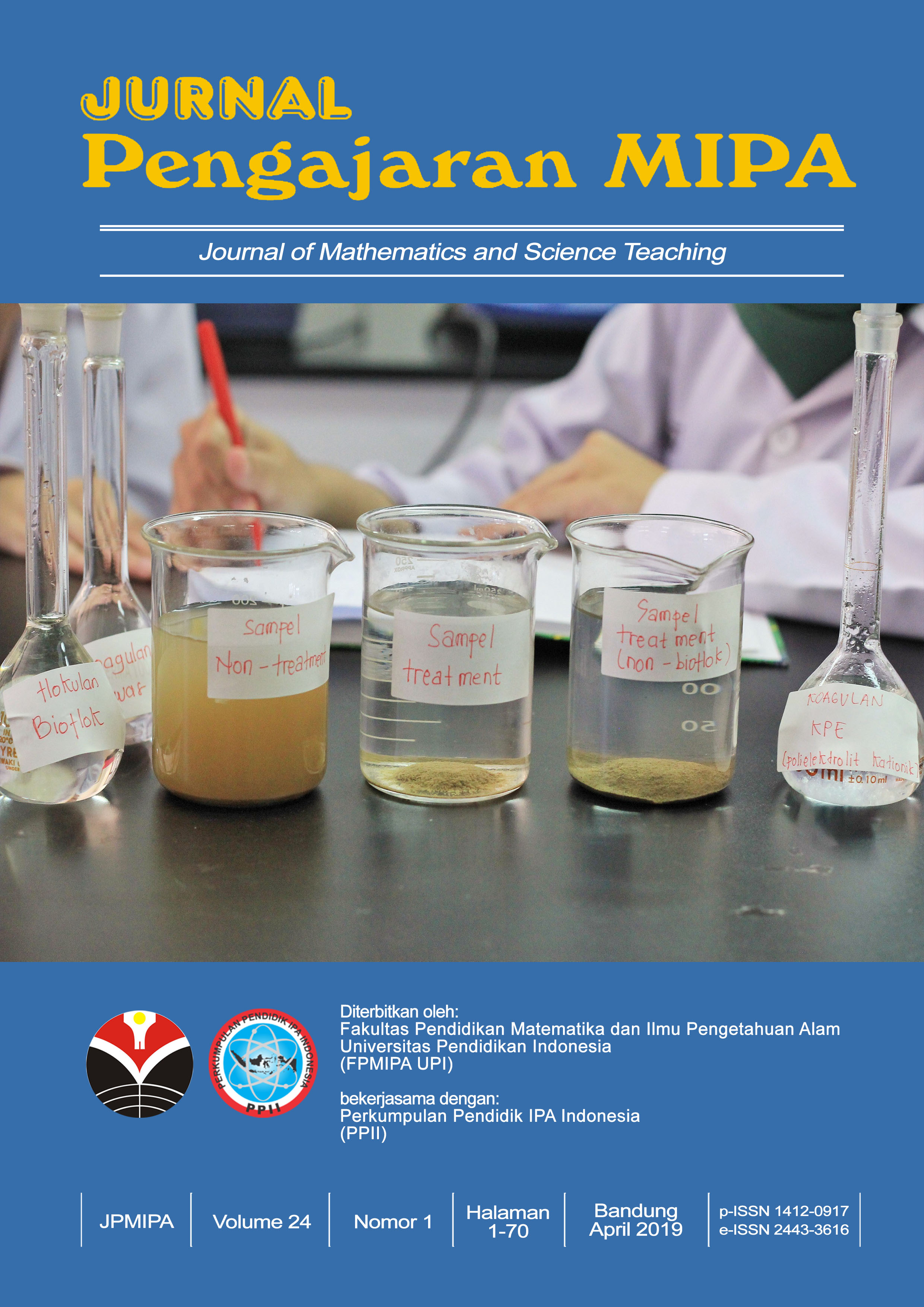MODEL PEMBERIAN TUGAS RESITASI (M-APOS) YANG DILAKSANAKAN DENGAN BAHASA INGGRIS DALAM MENGEMBANGKAN KEMAMPUAN KOMUNIKASI MATEMATIS DAN KEPERCAYAAN DIRI MAHASISWA CALON GURU
Abstract
ABSTRAK
Makalah ini menyajikan hasil observasi terhadap pembelajaran Aljabar Matrik yang menggunakan model M-APOS yang dilaksanakan dalam Bahasa Inggris untuk mengembangkan kemampuan komunikasi matematis dan kepercayaan diri mahasiswa calon guru. Implementasi pembelajaran menggunakan siklus ADL yang terdiri dari fase activities, fase class discussion dan fase exercises. Fase activities dalam penelitian dilaksanakan melalui tugas resitasi, dimana mahasiswa menyiapkan presentasi dengan memanfaatkan media power point dan menyajikannya dengan menggunakan bahasa inggris. Hasil pengamatan menunjukkan bahwa proses pembelajaran ini memberikan fasilitas dan kesempatan kepada mahasiswa untuk mengembangkan kemampuan mahaiswa dalam menumbuhkan kemampuan komunikasi matematis, belajar mandiri, menumbuhkan percaya diri dan memiliki tanggung jawab dalam menggali konsep yang harus dikuasainya. Hasil penelitian inipun menunjukkan bahwa aktivitas yang diberikan dapat menumbuhkan keterampilan menyajikan suatu materi dalam bentuk presentasi, memaksa mahasiswa untuk berkomunikasi matematika dengan bahasa inggris, dimana hal ini belum biasa dilaksanakan dalam perkuliahan umum.
ABSTRACT
This paper present the result of teaching and learning observation in Matrix Algebra Course by using M-APOS Model. The purpose of using M-APOS model to enhance pre-service students’ comunication and self confidence which conduct in english. Teaching and learning procces implemented by using ACE cycles (activities, class discussion, exercices). Activities fase was implemented by recitation task, in this fase student had to prepare power point media and the students had to presented in english; in class discussion, students had to discuss the related concept which presented in the class; and exercises fase, the students had to do some of problems (they can solve the problems in the class or whereever they can do). The result of the observation found that this teaching and learning process facilalitate and give chancing the students to improve their mathematical communication, self confidence, and responsibility to exploite the concept. And then this teaching and learning process suport the students to presented the concept in english, where this activities have not done before.
Keywords
Full Text:
PDFReferences
Albert, D. & Thomas, M. (1991). “Research on Mathematical Proof”. Dalam D. Tall (ed). Advanced Mathematical Thinking. Dordrecht : Kluwer Academic Publishers.
Alipandie, I. (1984). Didaktik Metodik Pendidikan Umum. Surabaya: PT. Usaha Nasional.
Asiala, M. et al. (1990). A Framework for Reseach and Curriculum Development in Undergraduate Mathematics Education. Reseach in Collegiate Mathematics Education II, CBMS Issue in Mathematics Education, 6, 1 – 32.
Asiala, M. et al. (1996).“The Development of students’ Understanding of Permutations and Symmetrics”.International Journal of Mathematical Learning, 3, 13-43
Astuti, et. al. (2004). Memanfaatkan ISETL untuk Membantu Mahasiswa Belajar Struktur Aljabar. Laporan Hibah Pengajaran. Dibiayai oleh Sub Proyek QUE Matematika – ITB. Bandung: Tidak dipublikasikan.
Brochlet, N. (2007). Cognitive Computer Tools in the Teaching and Learning of Undergraduate Calculus. International Journal for the Scholarship of Teaching and Learning. Tersedia: [Online]. http://www. Georgiasouthern, edu/ijsotl. [Juli 2009].
Brown, A. et al. (1997). “Leraning Binary Operation, Group, and Subgroup”. Journal of Mathematics Behavior, 16 (3). 187- 239.
Dubinsky, E & Leron, U. (1996). Learning Abstract Algebra with ISETL. New York: Springer-Verlag.
NAEP. (2003). What Does the NAEP Mathematics Assessment Measure?.[Online]. Tersedia: http://nces.ed.gov/nationsreportcard/mathemtics/ Whatmeasure. asp. [6 Juni 2005]
NCTM. (2000). NCTM: Principles and Standars for School Mathematics. [Online].Tersedia: http://krellinst.org/AiS/textbook/ Manual/stand/NCTM_stand.html. [20 Juni 2005].
Nurlaelah, E. dan Usdiyana, D. (2003).”Inovasi Pembelajaran Struktur Aljabar I dengan Menggunakan Program ISETL Berdasarkan Teori APOS”. Hibah Pembelajaran DUELIKE. UPI: Tidak Diterbitkan
Nurlaelah, E. (2009). Penggunaan Bahan Ajar Struktur Aljabar Yang Berbasis Program Komputer Dan Tugas Terstruktur Untuk Meningkatkan Kreativitas Dan Daya Matematik Mahasiswa. Laporan Hibah Bersaing –UPI. Tidak Diterbitkan.
Ruseffendi, E.T. (1991). Pengantar Kepada Membantu Guru Mengembangkan Kompetensinya dalam Pengajaran Matematika untuk Meningkatkan CBSA.Bandung: Tarsito.
Semiawan, C. (1985). Pendekatan Keterampilan Proses (Bagaimana Mengaktifkan Siswa Belajar). Jakarta: PT. Gramedia
Sumarmo, U. (2007). Pembelajaran matematika dalam Rujukan Filsafat, Teori dan Praksis Ilmu Pendidikan (Natawidjaja R, Sukmadinata, Ibrahim,R, Djohar A, Editor). Bandung: Universitas Pendidikan Indonesia Press
Wahyudin. (1999). Kemampuan Guru Matematika, Calon Guru Matematika,dan Mahasiswa Dalam Mata Pelajaran Matematika ( Studi Terhadap Tingkat Penguasaan Guru Matematika, Calon Guru Matematika, dan Mahasiswa dalam Mata Pelajaran Matematika, serta Kemampuan Mengajar Para Guru Matematika). Disertasi Doktor pada FPS- UPI. Bandung: Tidak diterbitkan
Williams, H. (2001). Preparation of Primary and secondary Mathematic Teachers: A working Group Report. Dalam: “ The Teaching and Learning of Mathematics t University Level. An IMI Study”. The Netherlands: Kluwer Academic Publishers.
Wilson, B. (1988). Making Sense of The Future. A Position Paper on Rule of Technology in Science, Mathematics and Computing Education. [On line]. Tersedia : http://hometown.aol.com. [29 Januari 2004]
DOI: https://doi.org/10.18269/jpmipa.v17i2.36075
Refbacks
- There are currently no refbacks.
Copyright (c) 2021 Jurnal Pengajaran MIPA

This work is licensed under a Creative Commons Attribution-ShareAlike 4.0 International License.
JPMIPA http://ejournal.upi.edu/index.php/jpmipa/index is licensed under a Creative Commons Attribution-ShareAlike 4.0 International License
Jurnal Pengajaran Matematika dan Ilmu Pengetahuan Alam (JPMIPA) or Journal of Mathematics and Science Teaching
All rights reserverd. pISSN 1412-0917 eISSN 2443-3616
Copyright © Faculty of Mathematics and Science Education (FPMIPA) Universitas Pendidikan Indonesia (UPI)
View JPMIPA Stats









